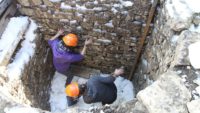 The archaeological site of Augusta Raurica outside Basel, Switzerland, has been excavated continuously for decades. It is the oldest known Roman colony on the Rhine but was never overbuilt after it was permanently disabled by earthquakes and barbarian raids in the 3rd century. Because of this, the site’s remains are extensive and in an excellent state of preservation. Today Augusta Raurica is by far the best preserved Roman city north of the Alps.
The archaeological site of Augusta Raurica outside Basel, Switzerland, has been excavated continuously for decades. It is the oldest known Roman colony on the Rhine but was never overbuilt after it was permanently disabled by earthquakes and barbarian raids in the 3rd century. Because of this, the site’s remains are extensive and in an excellent state of preservation. Today Augusta Raurica is by far the best preserved Roman city north of the Alps.
In 2013, a dig unearthed a number of stone-walled shafts. Archaeologists suspected they may have been used for cold storage. Romans would pack the space with snow and ice in the winter and add straw for insulation. Supplies stashed in the shaft could then be kept cool even when the sun was hot.
Peter-Andrew Schwarz from the University of Basel has experimented twice trying to get the refrigerator effect to work. The first time the team packed the shaft with snow, shoveling it all in in one fell swoop. This method did not work. The temperature inside the structure never even reached freezing during the winter.
The second attempt packed snow and ice into the shaft gradually, fitting ice blocks into gaps. This half-worked. The pit got cold and stayed cold until June.
Now, however, researchers plan to use methods developed by the so-called ‘nevaters’ or ice-makers on the Spanish island of Majorca. This will see Schwarz and his team placing 20–30-centimetre-thick layers of snow into the shaft. These individual layers will then be compacted down with a straw cover placed on top of each one.
“With this method, people in Majorca could keep food cool in summer before the arrival of electric fridges,” Schwarz told regional daily Basler Zeitung in 2017.
The experiment is taking place even as you read and the site is open to the public, as is its wont. Visitors will have the chance to see the pits while archaeologists work to figure out if they were used for refrigeration. The tests end on Friday.